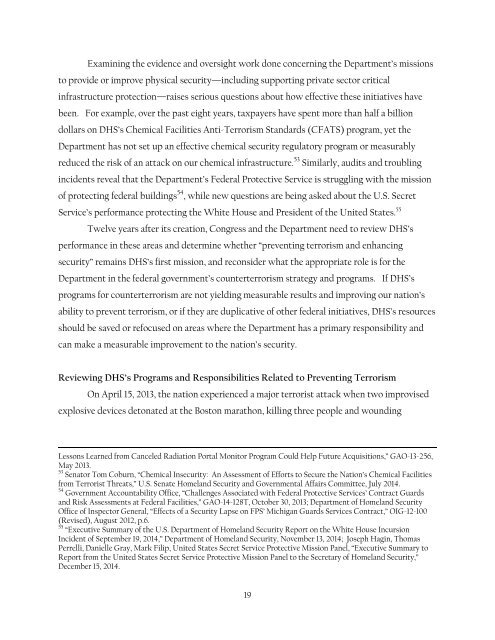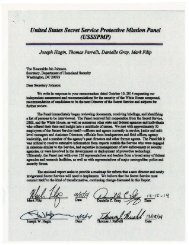010815as1
Create successful ePaper yourself
Turn your PDF publications into a flip-book with our unique Google optimized e-Paper software.
Examining the evidence and oversight work done concerning the Department’s missions<br />
to provide or improve physical security—including supporting private sector critical<br />
infrastructure protection—raises serious questions about how effective these initiatives have<br />
been. For example, over the past eight years, taxpayers have spent more than half a billion<br />
dollars on DHS’s Chemical Facilities Anti-Terrorism Standards (CFATS) program, yet the<br />
Department has not set up an effective chemical security regulatory program or measurably<br />
reduced the risk of an attack on our chemical infrastructure. 53 Similarly, audits and troubling<br />
incidents reveal that the Department’s Federal Protective Service is struggling with the mission<br />
of protecting federal buildings 54 , while new questions are being asked about the U.S. Secret<br />
Service’s performance protecting the White House and President of the United States. 55<br />
Twelve years after its creation, Congress and the Department need to review DHS’s<br />
performance in these areas and determine whether “preventing terrorism and enhancing<br />
security” remains DHS’s first mission, and reconsider what the appropriate role is for the<br />
Department in the federal government’s counterterrorism strategy and programs. If DHS’s<br />
programs for counterterrorism are not yielding measurable results and improving our nation’s<br />
ability to prevent terrorism, or if they are duplicative of other federal initiatives, DHS’s resources<br />
should be saved or refocused on areas where the Department has a primary responsibility and<br />
can make a measurable improvement to the nation’s security.<br />
Reviewing DHS’s Programs and Responsibilities Related to Preventing Terrorism<br />
On April 15, 2013, the nation experienced a major terrorist attack when two improvised<br />
explosive devices detonated at the Boston marathon, killing three people and wounding<br />
Lessons Learned from Canceled Radiation Portal Monitor Program Could Help Future Acquisitions,” GAO-13-256,<br />
May 2013.<br />
53 Senator Tom Coburn, “Chemical Insecurity: An Assessment of Efforts to Secure the Nation’s Chemical Facilities<br />
from Terrorist Threats,” U.S. Senate Homeland Security and Governmental Affairs Committee, July 2014.<br />
54 Government Accountability Office, “Challenges Associated with Federal Protective Services’ Contract Guards<br />
and Risk Assessments at Federal Facilities,” GAO-14-128T, October 30, 2013; Department of Homeland Security<br />
Office of Inspector General, “Effects of a Security Lapse on FPS’ Michigan Guards Services Contract,” OIG-12-100<br />
(Revised), August 2012, p.6.<br />
55 “Executive Summary of the U.S. Department of Homeland Security Report on the White House Incursion<br />
Incident of September 19, 2014,” Department of Homeland Security, November 13, 2014; Joseph Hagin, Thomas<br />
Perrelli, Danielle Gray, Mark Filip, United States Secret Service Protective Mission Panel, “Executive Summary to<br />
Report from the United States Secret Service Protective Mission Panel to the Secretary of Homeland Security,”<br />
December 15, 2014.<br />
19








![55721335-d6fe09eb5ffdcc87dbf6c3f0b5bbda07d2261e98[1]](https://img.yumpu.com/56533583/1/186x260/55721335-d6fe09eb5ffdcc87dbf6c3f0b5bbda07d2261e981.jpg?quality=85)








